中国象棋规则英文版
2024年新规:中国象棋比赛规则英文版

2024年新规:中国象棋比赛规则英文版2024 Chinese Chess Competition RulesIn 2024, new regulations will be introduced for Chinese chess competitions. The updates aim to enhance the overall playing experience and fairness for all participants. These rules will cover various aspects of the game, including time limits, piece movement, and scoring systems.One significant change in the 2024 rules involves the time limits for each player. The time allocated for making moves will be adjusted to ensure games progress at a reasonable pace. This adjustment aims to prevent unnecessary delays and keep the competition moving smoothly.Another key aspect of the updated rules is the clarification of piece movement. The regulations will provide detailed instructions on how each chess piece can move on the board. This clarity aims to eliminate any confusion or disputes during gameplay, ensuring a more straightforward and enjoyable experience for all players.Additionally, the scoring system will be revised to better reflect the skill and strategy of each player. The new rules will assign points based on the outcome of each game, rewarding players for their performance and sportsmanship. This adjustment aims to promote fair competition and recognize the efforts of all participants.Overall, the 2024 Chinese Chess Competition Rules aim to create a more organized and competitive environment for players. These updates will help streamline gameplay, clarify rules, and encourage sportsmanship among participants. By following these regulations, players can expect a more engaging and rewarding experience in Chinese chess competitions.。
象棋介绍英文作文带翻译

象棋介绍英文作文带翻译Title: Introduction to Chinese Chess (象棋介绍)。
Chinese Chess, also known as Xiangqi, is a strategic board game that has been played for centuries in China and other parts of Asia. Similar to Western chess, Chinese Chess involves two players who compete against each other by moving pieces on a checkered board, aiming to capture the opponent's king. In this introduction, we will delve into the rules, history, and strategies of Chinese Chess.Rules of Chinese Chess:The game is played on a board that consists of 10 horizontal lines (called ranks) and 9 vertical lines (called files), forming 90 intersections. The pieces are placed on these intersections rather than within the squares as in Western chess.Each player starts with 16 pieces, which are placed onthe intersections of the board. The pieces include a general (or king), two guards, two ministers (or advisors), two elephants, two horses, two chariots (or rooks), two cannons, and five soldiers (or pawns).The objective of the game is to checkmate theopponent's general. Unlike in Western chess, there is no concept of checkmate in Chinese Chess. Instead, the game ends when one player's general is in a position where it cannot escape capture.Each type of piece has its own unique way of moving. For example, the general moves one point orthogonally (along the lines), the guard moves one point diagonally within the palace, the horse moves in an "L" shape, and the cannon moves by jumping over exactly one piece (friend or foe) to capture an opponent's piece.History of Chinese Chess:Chinese Chess has a rich history dating back over a millennium. Its origins can be traced to ancient China,where it was initially played by nobility and military commanders as a means of strategic training. Over time, the game became popular among the masses and spread throughout East Asia.The earliest known references to Chinese Chess date back to the Tang Dynasty (7th to 10th centuries AD), although the game likely existed in some form even earlier. Throughout its history, Chinese Chess has undergone various changes and adaptations, reflecting the cultural and societal developments of the time.Today, Chinese Chess remains a beloved pastime in China and other Asian countries. It is often played in parks, community centers, and even online platforms, attracting players of all ages and skill levels.Strategies in Chinese Chess:Like Western chess, Chinese Chess requires strategic thinking, foresight, and tactical maneuvering to outwit the opponent. Here are some key strategies to keep in mind:1. Control the center: Dominating the central squares of the board allows for greater mobility and control over the game.2. Protect the general: The safety of the general is paramount. Always be vigilant in guarding against potential threats to your king.3. Develop your pieces: Efficiently mobilize your pieces to occupy key positions on the board, coordinating their movements to support each other.4. Plan ahead: Anticipate your opponent's moves and formulate a long-term strategy to gain positional advantages and create threats.5. Exploit weaknesses: Identify weaknesses in your opponent's position and capitalize on them by launching coordinated attacks or exploiting tactical opportunities.By mastering these strategies and understanding thenuances of Chinese Chess, players can enhance their skills and enjoy a rewarding and challenging gaming experience.In conclusion, Chinese Chess is a captivating and intellectually stimulating game that offers a unique blendof tradition, strategy, and skill. Whether played casually for recreation or competitively at a professional level, it continues to captivate players around the world with its timeless appeal.象棋(Chinese Chess)简介:象棋,又称中国象棋,是一种源自中国并在亚洲其他地区流行的战略性棋类游戏。
中国象棋规则英文版

Xiangqi, or Chinese Chess, is an extremely popular game in the Eastern Hemisphere. It is currently played by millions (or tens of millions) in China, Taiwan, Thailand, Singapore, Vietnam, Hong Kong and other Asian countries. Xiangqi has remained in its present form for centuries. It is believed that both Xiangqi and Orthodox Chess derive from the original Indian game of Chanturanga.(xiáng) (qí ) translates to Elephant Game. In Mandarin it iswritten as either Xiangqi, Xiang Qi or Hsiang-Ch`i and pronounced "Shiang-Chi". In Cantonese it is written as Jeuhng Keih and pronounced "Junk Kay".The name Xiangqi has an interesting origin. Of China's four traditional arts -- qin (music), hua (brush pai nting), shu (calligraphy) and qí (strategy games) -- the latter term, qi, provides the final syllable of Xiangqi. There is much literature on Xiangqi, most of it in Chinese. There are, however, a few books available in English and other languages.Xiangqi sets can be procured from a number of sources. The most obvious of these are shops in the Chinese districts of large cities. Often, such sets are quite cheap, consisting of a paper board and flat wooden counters inscribed with red and black pictograms. These traditional Chinese symbols may appear strange to the western eye, but can easily be recognized with a minimum of practice. (For more sophisticated sets, see below.)RulesThe boardThe Xiangqi board is made up of ten horizontal lines and nine vertical lines. The verticals are interrupted by a central-horizontal void called a river. Two palaces are positioned at opposite sides of the board. Each is distinguished by a cross connecting its four corner points.NOTE: Orthodox Chess pieces are played on squares; Xiangqi Chesspieces are played on line intersections which are called points.The above board shows various L-shaped markings in order to distinguish the setup points of Pawns and Cannons. These markings are not present on all commercial boards.PiecesEach player has the following pieces:2 Rooks (R) (or chariots)2 Knights (N) (or horses)2 Elephants (M) (or bishops or ministers)2 Mandarins (G) (or advisors or assistants or guards)1 King (K) (or generals)2 Cannons (C)5 Pawns (P) (or soldiers)The Xiangqi array is shown below:Traditional Pieces Westernized PiecesFrom left to right on the bottom and top rows, you see: a Rook, a Knight, a Minister, a Guard, a King, a Guard, a Minister, a Knight, and a Rook. On the third rows, you see the Cannons, and on the fourth row you see the Pawns. Pieces at the bottom half are red.Chinese PiecesMovementWesternizedPieces RooksThe Rook moves as an orthodox Rook. (See Rook formore information.)Knights (Mao)The Knight moves one point orthogonally followedby one point outward-diagonally. It may not leapover occupied points. (See Mao for moreinformation.)ElephantsThe Elephant moves exactly two pointsdiagonally. It may not leap over occupied points. Also, Elephants are confined to their home side of the river. Due to these limitations, the Elephant can see only seven points of the board. (See Elephant for more information.) [The symbols on red and black Elephants differ, but their moves are the same.]MandarinsThe Mandarin (or Guard) moves one point diagonally. It may never leave the palace. [The symbols on red and black Mandrians differ, but their moves are the same.]King or GeneralThe King moves as an orthodox King, but cannot move diagonally. It may never leave the palace. (See King for more information.) [The symbols on red and black Kings differ, but their moves are the same.]The two Kings cannot face each other on an open file. For example, a red King on e1 and a black King on e9, with no piece on the e-file between them, is an illegal position. If either King sits exposed on an open file, the other King may not move to occupy that file.Cannons (Pao)The Cannon moves differently when it moves to capture than when it moves passively.1.The Cannon moves passively as an orthodoxRook2.The Cannon moves to capture as an orthodoxRook which is required to hop over a singlescreen.In other words, Cannons capture by hoping overa second piece in order to capture a third piece.For example, a Cannon on a1 can take a piece onf1 when exactly one of the points b1, c1, d1, ore1 is occupied by a piece of either color. Cannonsonly capture when hoping and only hop whencapturing. They may never hop over more than onepiece in a given move. (See Cannon for moreinformation.)PawnsUnlike orthodox Pawns, the Xiangqi Pawn'spassive move and capture move are always thesame. A starting Pawn moves one pointstraight-forward. A Pawn crossing the riverpromotes, keeping its old move and gaining a newmove -- a one-point step to either horizontal.Pawns do not promote on the last rank, where theycan move only left or right. (See Xiangqi Pawnfor more information.) [The symbols on red andblack Pawns differ, but their moves are thesame.]Other rules1.Red moves first.2.The game is won by checkmating or stalemating the opponent King.3.Perpetual check is forbidden. You cannot check your opponent morethan three times in a row with the same piece and same boardpositions.4.You cannot force an enemy piece to move to and from the same twopoints, indefinitely, in order to avoid capture. If you move a Rook to e5, threatening a Cannon on e6, and your opponent's only viable move is Cannon to f6, then you cannot force that Cannon to and from e6 and f6 by moving your Rook to and from e5 and f5, indefinitely.The purpose of this rule (and the above rule) is to avoidperpetual-check draws. Some of these situations are complicated, but the person who is forcing the perpetual move must usually break it off.5.The game is a draw when neither side can force a checkmate or astalemate.。
2024年版:中国象棋竞技规则英文版

2024年版:中国象棋竞技规则英文版2024 Chinese Chess Competition RulesWelcome to the official rules for the 2024 Chinese Chess competition. In this document, we will outline the regulations and guidelines that all players must adhere to during the tournament.Game Setup- The game is played on a board with 9 vertical lines and 10 horizontal lines, totaling 90 intersections.- Each player starts with 16 pieces, including generals, advisors, elephants, horses, chariots, cannons, and soldiers.Objective- The objective of the game is to checkmate the opponent's general.- Players take turns moving their pieces across the board strategically to achieve this goal.Movement Rules- Each piece has specific movement rules and restrictions.- Pieces can move horizontally or vertically within the confines of the board.- Capturing opponent's pieces is allowed by moving a piece onto the same intersection occupied by the opponent's piece.General Rules- The game ends when one player checkmates the opponent's general.- Stalemate results in a draw.- Illegal moves result in penalties or disqualification.Time Limit- Each player has a designated amount of time to make their moves.- Overtime may result in penalties or disqualification.Tournament Format- The tournament consists of multiple rounds with elimination.- Players compete in head-to-head matches until a winner is determined.Conduct Rules- Players must display sportsmanship and respect towards opponents and officials.- Cheating or unsportsmanlike conduct will result in disqualification.Scoring- Players earn points for wins and draws.- The player with the highest score at the end of the tournament is declared the champion.Conclusion- These rules are designed to ensure fair play and competitive integrity in the 2024 Chinese Chess competition.- Players are encouraged to study and understand the rules thoroughly before participating in the tournament.。
象棋规则(英文)

Chinese ChessXiangqi, or Chinese Chess, is an extremely popular game in the Eastern Hemisphere. It is currently played by millions (or tens of millions) in China's mainland, Taiwan, Thailand, Singapore, Vietnam, Hong Kong and other Asian countries. Xiangqi has remained in its present form for centuries.The name Xiangqi has an interesting origin. Of China's four traditional arts -- qin (music), hua (brush painting), shu (calligraphy) and qi (strategy games) -- the latter term, qi, provides the final syllable of Xiangqi .HistoryChinese chess has a long history. Its origin has not been confirmed yet. But judging by its rules, we can conclude that the origin of Chinese chess was closely related to military strategists in ancient China.During the Spring and Autumn Period and the Warring States Period, wars were fought for years running. A new chess game was patterned after the array of troops. This was the earliest form of Chinese chess. During the Wei, Jin and Northern and Southern Dynasties, a kind of chess game was popular among the people. It laid a foundation for the finalized pattern of the Chinese chess.In ancient times, the Chinese chess was always enjoyed by both highbrows and lowbrows.During the reign of Suzong of the Tang Dynasty, Prime Minister Niu Sengru wrote a fake story about chess. That occurred during the Baoying period, so it was named Baoying chess. Baoying chess had six pieces. He wrote about the rules of the chess. Baoying chess produced a significant influence on the chess in subsequent years.Three forms of chess took shape after the Song Dynasty. One of them consisted of 32 pieces. They were played on a chessboard with 9 vertical lines and 9 horizontal lines. Popular in those days was a chessboard without a river borderline. The Chu River and Han Borderline were added later. This form has lasted to this day.With the economic and cultural development during the Qing Dynasty, the Chinese chess entered a new stage. Many different schools of chess circles and chess players came into prominence. With the popularization of the Chinese chess, many books and manuals on the techniques of playing chess were published. They played an important role in popularizing the Chinese chess and improving the techniques of playing in modern times.PiecesEach player has the following pieces:2 Rooks (R) (or chariots)2 Knights (N) (or horses)2 Elephants (M) (or bishops or ministers)2 Mandarins (G) (or advisers or assistants or guards)1 King (K) (or generals)2 Cannons (C)5 Pawns (P) (or soldiers)MoveRooks (jū 車)The Rook moves as an orthodox Rook.Knights (mǎ 馬)The Knight moves one point orthogonally followed by one point outward-diagonally. It may not leap over occupied points.Elephants (xiànɡ相or象)The Elephant moves exactly two points diagonally. It may not leap over occupied points. Also, Elephants are confined to their home side of the river. Due to these limitations, the Elephant can see only seven points of the board. [The symbols on red and black Elephants differ, but their moves are the same.]Mandarins (shì士or仕)The Mandarin (or Guard) moves one point diagonally. It may never leave the palace. [The symbols on red and black Mandrians differ, but their moves are the same.]King or General(shuài帅or jiànɡ将)The King moves as an orthodox King, but cannot move diagonally. It may never leave the palace. [The symbols on red and black Kings differ, but their moves are the same.]The two Kings cannot face each other on an open file. For example, a red King on e1 and a black King on e9, with no piece on the e-file between them, is an illegal position. If either King sits exposed on an open file, the other King may not move to occupy that file.Cannons (pào 炮)The Cannon moves differently when it moves to capture than when it moves passively.The Cannon moves passively as an orthodox RookThe Cannon moves to capture as an orthodox Rook which is required to hop over a single screen.In other words, Cannons capture by hoping over a second piece in order to capture a third piece. For example, a Cannon on a1 can take a piece on f1 when exactly one of the points b1, c1, d1, or e1 is occupied by a piece of either color. Cannons only capture when hoping and only hop when capturing. They may never hop over more than one piece in a given move.Pawns (bīnɡ兵or zú卒)Unlike orthodox Pawns, the Xiangqi Pawn's passive move and capture move are always the same. A starting Pawn moves one point straight-forward. A Pawn crossing the river promotes, keeping its old move and gaining a new move -- a one-point step to either horizontal. Pawns do not promote on the last rank, where they can move only left or right.[The symbols on red and black Pawns differ, but their moves are the same.]。
(2024年更新)全国象棋比赛新规则英文版
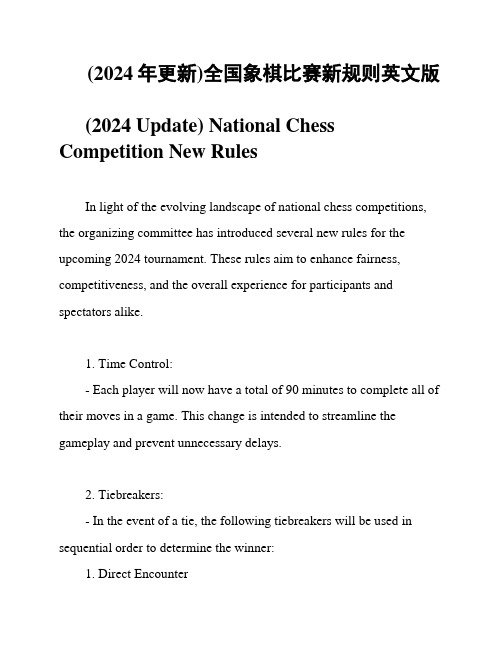
(2024年更新)全国象棋比赛新规则英文版(2024 Update) National Chess Competition New RulesIn light of the evolving landscape of national chess competitions, the organizing committee has introduced several new rules for the upcoming 2024 tournament. These rules aim to enhance fairness, competitiveness, and the overall experience for participants and spectators alike.1. Time Control:- Each player will now have a total of 90 minutes to complete all of their moves in a game. This change is intended to streamline the gameplay and prevent unnecessary delays.2. Tiebreakers:- In the event of a tie, the following tiebreakers will be used in sequential order to determine the winner:1. Direct Encounter2. Sonneborn-Berger3. Number of Wins4. Coin Toss3. Electronic Devices:- The use of electronic devices, such as smartphones and tablets, during matches is strictly prohibited. This rule is enforced to maintain the integrity of the game and prevent any unfair advantages.4. Spectator Etiquette:- Spectators are required to maintain a respectful and quiet environment during matches. Any disruptions or distractions caused by spectators may result in removal from the premises.5. Arbitration:- In cases of disputes or rule violations, the decision of the tournament arbiters is final and binding. Participants are expected to comply with the arbiters' rulings without hesitation.6. Fair Play:- Fair play is paramount in the national chess competition. Any form of cheating, collusion, or unethical behavior will result in immediate disqualification and potential banning from future events.7. Registration Requirements:- Participants must register for the tournament in advance and provide valid identification to verify their eligibility. Failure to meet registration requirements may result in exclusion from the competition.8. Prize Distribution:- Prizes will be awarded to winners and top performers in each category. The distribution of prizes will be announced at the conclusion of the tournament and awarded accordingly.9. Code of Conduct:- All players, coaches, officials, and spectators are expected to adhere to a code of conduct that promotes respect, sportsmanship, and fair play. Violations of the code of conduct may result in disciplinary action.These new rules have been carefully crafted to uphold the integrity and spirit of national chess competitions while ensuring a positive and enjoyable experience for all participants. We look forward to seeing these rules in action at the 2024 tournament and wish all participants the best of luck in their matches.。
中国象棋英文说明书
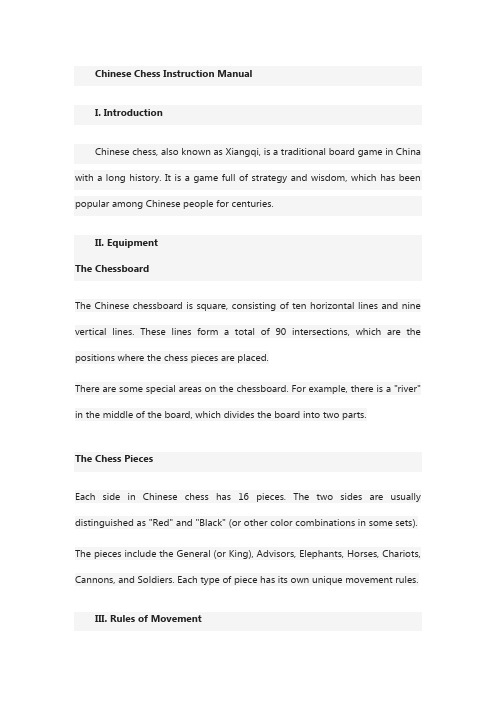
Chinese Chess Instruction ManualI. IntroductionChinese chess, also known as Xiangqi, is a traditional board game in China with a long history. It is a game full of strategy and wisdom, which has been popular among Chinese people for centuries.II. EquipmentThe ChessboardThe Chinese chessboard is square, consisting of ten horizontal lines and nine vertical lines. These lines form a total of 90 intersections, which are the positions where the chess pieces are placed.There are some special areas on the chessboard. For example, there is a "river" in the middle of the board, which divides the board into two parts.The Chess PiecesEach side in Chinese chess has 16 pieces. The two sides are usually distinguished as "Red" and "Black" (or other color combinations in some sets). The pieces include the General (or King), Advisors, Elephants, Horses, Chariots, Cannons, and Soldiers. Each type of piece has its own unique movement rules.III. Rules of MovementGeneral (King)The General can only move one step at a time, either horizontally or vertically, within the "palace" area, which is a small square area in the center of each side's territory.AdvisorsAdvisors can only move diagonally within the "palace" area, also one step at a time.ElephantsElephants move two squares diagonally. However, they cannot cross the "river", and there is a so - called "blocking elephant's eye" rule. If there is a piece (of either side) on the square adjacent to the elephant's starting point in the middle of its diagonal movement path, the elephant cannot move in that direction.HorsesHorses move in an L - shape, which means one square horizontally or vertically and then one square diagonally. If there is a piece on the square immediately next to the horse in the direction of its first move (horizontally or vertically), the horse is "blocked" and cannot move in that L - shape in that direction. This is known as "horse's hoof - blocked".ChariotsChariots can move any number of squares horizontally or vertically as long as there are no other pieces blocking their path. They are very powerful pieces for attacking and defending.CannonsCannons move like chariots, but when they want to "capture" an enemy piece, they need to have a "jump - over" piece (of either side). That is, there must be a piece between the cannon and the piece it wants to capture, and then it can jump over this piece to capture the target piece.SoldiersSoldiers can only move one step forward when they are on their own side of the "river". Once they cross the "river", they can move one step forward or one step horizontally (left or right).IV. Rules of the GameStarting PositionAt the beginning of the game, all the pieces are placed in their initial positions on the chessboard according to the rules.Taking TurnsThe two players take turns to move their pieces. Usually, Red moves first. Objective of the GameThe goal of the game is to checkmate the opponent's General (King). That is, to put the opponent's General in a position where it is under attack and has no legal move to escape.If a player's General is in a "stalemate" situation (where the General is not in check but has no legal move), the game is considered a draw.There are also some other situations that can result in a draw, such as both sides agreeing to a draw, or when a certain number of moves are repeated without any significant progress in the game.Capturing PiecesWhen a piece moves to a position where it can capture an opponent's piece according to the movement rules, the opponent's piece is removed from the board.V. Tips and StrategiesEarly - Game StrategiesIn the early game, it is important to develop your pieces quickly and control key areas of the chessboard. For example, chariots can be moved out early to gain control of the main lines (horizontal and vertical).Protecting your important pieces, such as the General and Advisors, is also crucial in the early stage.Mid - Game StrategiesAs the game progresses, look for opportunities to attack the opponent's weaknesses. Coordinate the movement of different pieces, such as using horses and cannons together to create threats.Try to break through the opponent's defense line by using a combination of pieces.Late - Game StrategiesIn the late game, when there are fewer pieces on the board, be more cautious with each move. The position of the General becomes even more critical, and one wrong move can lead to a quick defeat.Try to simplify the game situation if you have an advantage, or look for ways to create a draw if you are at a disadvantage.。
(2024年更新)中国象棋冠军赛规则英文版

(2024年更新)中国象棋冠军赛规则英文版(2024 Update) Chinese Chess Championship RulesWelcome to the official document outlining the rules for the 2024 Chinese Chess Championship. This prestigious competition brings together the best players from across the country to compete for the title of champion.Tournament FormatThe championship will be held in a round-robin format, with each player facing off against all other participants. The top players from the round-robin stage will then advance to the knockout rounds, culminating in the final match to determine the champion.Time ControlEach player will have a set amount of time to make their moves during the games. The time control will be enforced strictly to ensure fair play and to keep the games moving at a steady pace.Scoring SystemPlayers will earn points based on the results of their games. A win will earn a player 1 point, a draw will earn 0.5 points, and a loss will earn 0 points. The player with the most points at the end of the tournament will be crowned the champion.TiebreaksIn the event of a tie in points at the end of the tournament, tiebreak criteria will be used to determine the final standings. These criteria may include head-to-head results, performance rating, and other factors to ensure a fair outcome.Code of ConductAll players are expected to conduct themselves with the utmost professionalism and sportsmanship throughout the championship. Any violations of the code of conduct may result in penalties or disqualification from the tournament.Prize PoolThe championship offers a generous prize pool for the top finishers, with the champion receiving the largest share of the winnings. This provides added incentive for players to perform at their best and compete for the title.ConclusionWe hope that the rules outlined in this document provide clarity and guidance for all participants in the 2024 Chinese Chess Championship. Good luck to all the players, and may the best player emerge victorious as the new champion.。
中国象棋:ChineseXiangqi
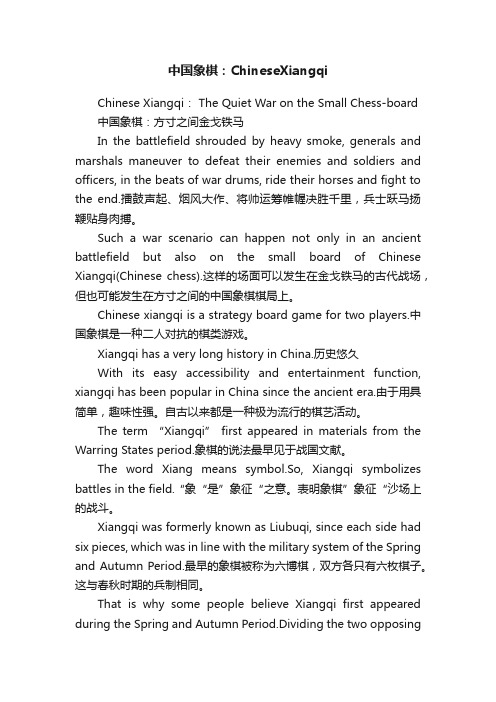
中国象棋:ChineseXiangqiChinese Xiangqi: The Quiet War on the Small Chess-board 中国象棋:方寸之间金戈铁马In the battlefield shrouded by heavy smoke, generals and marshals maneuver to defeat their enemies and soldiers and officers, in the beats of war drums, ride their horses and fight to the end.擂鼓声起、烟风大作、将帅运筹帷幄决胜千里,兵士跃马扬鞭贴身肉搏。
Such a war scenario can happen not only in an ancient battlefield but also on the small board of Chinese Xiangqi(Chinese chess).这样的场面可以发生在金戈铁马的古代战场,但也可能发生在方寸之间的中国象棋棋局上。
Chinese xiangqi is a strategy board game for two players.中国象棋是一种二人对抗的棋类游戏。
Xiangqi has a very long history in China.历史悠久With its easy accessibility and entertainment function, xiangqi has been popular in China since the ancient era.由于用具简单,趣味性强。
自古以来都是一种极为流行的棋艺活动。
The term “Xiangqi” first appeared in materials from the Warring States period.象棋的说法最早见于战国文献。
英语演讲稿中国象棋文化
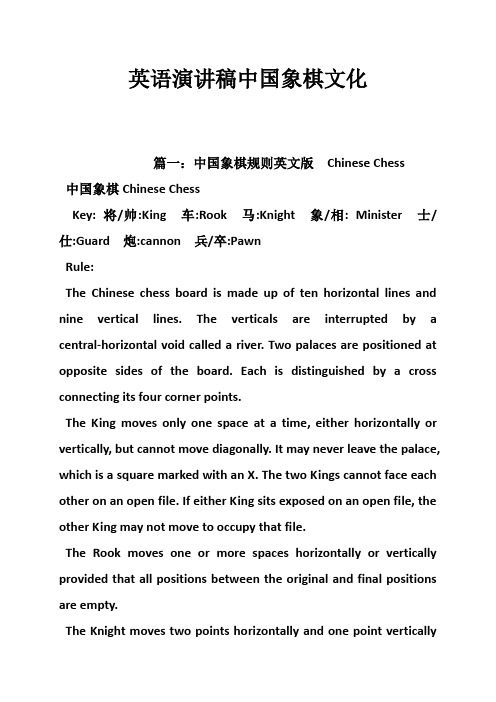
英语演讲稿中国象棋文化篇一:中国象棋规则英文版Chinese Chess中国象棋Chinese ChessKey: 将/帅:King 车:Rook 马:Knight 象/相: Minister 士/仕:Guard 炮:cannon 兵/卒:PawnRule:The Chinese chess board is made up of ten horizontal lines and nine vertical lines. The verticals are interrupted by a central-horizontal void called a river. Two palaces are positioned at opposite sides of the board. Each is distinguished by a cross connecting its four corner points.The King moves only one space at a time, either horizontally or vertically, but cannot move diagonally. It may never leave the palace, which is a square marked with an X. The two Kings cannot face each other on an open file. If either King sits exposed on an open file, the other King may not move to occupy that file.The Rook moves one or more spaces horizontally or vertically provided that all positions between the original and final positions are empty.The Knight moves two points horizontally and one point vertically(or respectively 2 points vertically and 1 point horizontally). If there is a piece next to the horse in the horizontal (vertical) direction, the horse is blocked and the move is not allowed.The Minister moves exactly two points diagonally. If there is a piece midway between the original and final intended position of a minister, the Minister is blocked and the move is not allowed. Also, Ministers are confined to their home side of the river. Due to these limitations, the Minister can see only seven points of the board.The Guard moves one point diagonally. It may never leave the palace. Due to these limitations, the Guard can see only five points of the board.The Cannon moves differently when it moves to capture than when it moves passively. It moves one or more points horizontally or vertically like the Rook. However, in a capture move, there must be exactly one non-empty space in between the original and final position. In a non-capture move, all spaces in between must be empty.The Pawn's passive move and capture move are always the same. A starting Pawn moves one point straight-forward. A Pawn crossing the river promotes, keeping its old move and gaining a new move -- a one-point step to either horizontal. Pawns do not promoteon the last rank, where they can move only left or right. It go and never come back.将/帅:King車/俥:Rook马/馬:Knight象/相: Minister士/仕:Guard砲/炮:Cannon卒/兵:Pawn篇二:象棋大赛演讲稿象棋大赛演讲稿各位同学,各位参赛队员,各位领导大家好:值此新学期的开始,为丰富校园文化生活,我们在校园举办了此次象棋比赛,为庆祝各位参赛队员的到来,我们的比赛即将拉开帷幕,我对运动员的到来表示衷心的祝贺和热烈地欢迎:人生就是一局棋,我们每时每刻走的是不同的路,自己就是一军主帅,正邪之事被楚河汉界分两边,无论自己手中快車巧马,侍卫丞相,必须要做到攻守自如,首尾呼应,切勿急躁,否则一招走错误天下。
2020年中国象棋比赛规则详解英文版
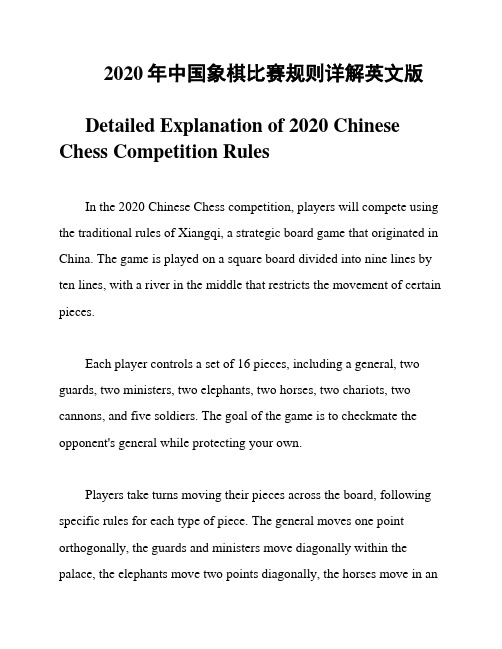
2020年中国象棋比赛规则详解英文版Detailed Explanation of 2020 Chinese Chess Competition RulesIn the 2020 Chinese Chess competition, players will compete using the traditional rules of Xiangqi, a strategic board game that originated in China. The game is played on a square board divided into nine lines by ten lines, with a river in the middle that restricts the movement of certain pieces.Each player controls a set of 16 pieces, including a general, two guards, two ministers, two elephants, two horses, two chariots, two cannons, and five soldiers. The goal of the game is to checkmate the opponent's general while protecting your own.Players take turns moving their pieces across the board, following specific rules for each type of piece. The general moves one point orthogonally, the guards and ministers move diagonally within the palace, the elephants move two points diagonally, the horses move in anL-shape, the chariots move orthogonally, the cannons jump over a piece to capture, and the soldiers move forward one point.Players can also capture their opponent's pieces by landing on the same square, except for the soldiers, which capture diagonally. The game ends when one player successfully checkmates the opponent's general or achieves a stalemate.In addition to the basic rules of Xiangqi, the 2020 competition may have specific tournament rules, time controls, and scoring systems. Players are expected to follow these regulations to ensure fair play and sportsmanship.Overall, the 2020 Chinese Chess competition will test players' strategic thinking, tactical skills, and ability to adapt to different game situations. It is a challenging and exciting event that showcases the rich tradition of Xiangqi in China.。
(2024年修订)中国象棋比赛新规定英文版
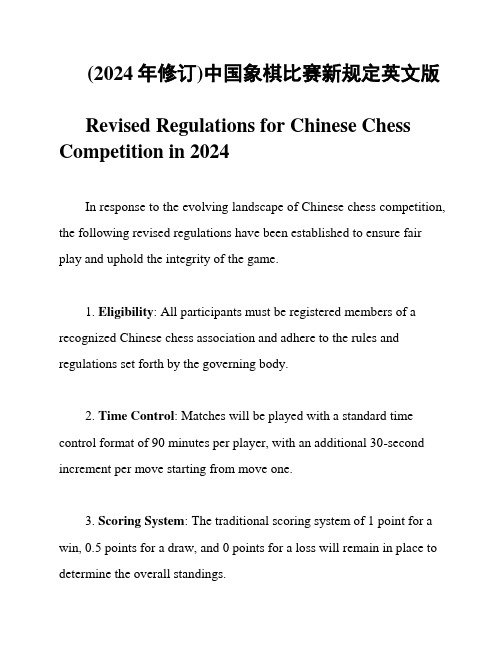
(2024年修订)中国象棋比赛新规定英文版Revised Regulations for Chinese Chess Competition in 2024In response to the evolving landscape of Chinese chess competition, the following revised regulations have been established to ensure fair play and uphold the integrity of the game.1. Eligibility: All participants must be registered members of a recognized Chinese chess association and adhere to the rules and regulations set forth by the governing body.2. Time Control: Matches will be played with a standard time control format of 90 minutes per player, with an additional 30-second increment per move starting from move one.3. Scoring System: The traditional scoring system of 1 point for a win, 0.5 points for a draw, and 0 points for a loss will remain in place to determine the overall standings.4. Tournament Structure: Tournaments will be conducted in a round-robin format, with each player facing every other player in the competition. Tiebreakers will be determined by head-to-head results, followed by Buchholz and Sonneborn-Berger systems if necessary.5. Equipment: All players must use regulation Chinese chess sets and boards provided by the organizing committee. Electronic devices, notes, and other external aids are strictly prohibited during gameplay.6. Fair Play: Any form of cheating, including collusion with opponents, use of computer assistance, or unauthorized communication during games, will result in immediate disqualification and potential suspension from future events.7. Code of Conduct: Participants are expected to conduct themselves in a respectful and sportsmanlike manner at all times. Unsportsmanlike behavior, including verbal abuse, physical altercations, or other disruptive actions, will not be tolerated.8. Officials and Arbiters: Trained officials and arbiters will oversee all matches to enforce the regulations and ensure a smooth and orderly competition. Their decisions are final and binding.9. Prize Distribution: Prizes will be awarded to the top finishers in each tournament, with monetary rewards and trophies given to the winners, runners-up, and other distinguished performers.10. Amendment Procedure: Any proposed changes or additions to these regulations must be submitted in writing to the governing body for review and approval before implementation.These revised regulations aim to enhance the competitive environment of Chinese chess tournaments while upholding the spirit of fair play and sportsmanship among all participants. By adhering to these guidelines, we can continue to promote the growth and popularity of Chinese chess on a global scale.。
2024年的中国象棋比赛规定英文版
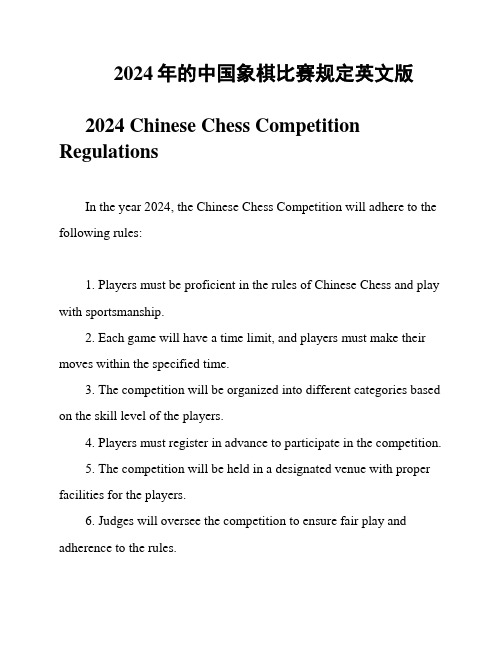
2024年的中国象棋比赛规定英文版2024 Chinese Chess Competition RegulationsIn the year 2024, the Chinese Chess Competition will adhere to the following rules:1. Players must be proficient in the rules of Chinese Chess and play with sportsmanship.2. Each game will have a time limit, and players must make their moves within the specified time.3. The competition will be organized into different categories based on the skill level of the players.4. Players must register in advance to participate in the competition.5. The competition will be held in a designated venue with proper facilities for the players.6. Judges will oversee the competition to ensure fair play and adherence to the rules.7. The winner of each category will be determined based on a point system or knockout rounds.8. Prizes will be awarded to the winners in each category.9. Players must follow the instructions of the organizers and judges throughout the competition.10. Any disputes or rule violations will be addressed by the judges and may result in penalties or disqualification.These regulations aim to ensure a fair and competitive environment for all participants in the 2024 Chinese Chess Competition.。
(2024年更新)象棋比赛规则与指南英文版

(2024年更新)象棋比赛规则与指南英文版(2024 Updated) Chess Competition Rules and GuideWelcome to the 2024 Chess Competition! Whether you are a seasoned player or new to the game, this document will provide you with all the rules and guidelines you need to compete effectively.Overview:- The competition will be held on [date] at [location].- Participants must register by [deadline] to secure their spot.- The competition will follow standard chess rules and regulations.Rules:1. Each player will have a total of [time limit] to make their moves.2. Illegal moves will result in a penalty or disqualification.3. Players must follow proper etiquette and sportsmanship throughout the competition.4. The use of electronic devices is strictly prohibited during gameplay.5. The competition will consist of [number] rounds, with the winner determined by the highest cumulative score.Guidelines:- Players are responsible for bringing their own chess set and clock.- Spectators are welcome to attend and support their favorite players.- Refreshments will be provided during breaks between rounds.- Winners will be awarded [prizes] at the end of the competition.We wish all participants the best of luck and look forward to a competitive and enjoyable event!See you at the chessboard!。
象棋术语中英文对照
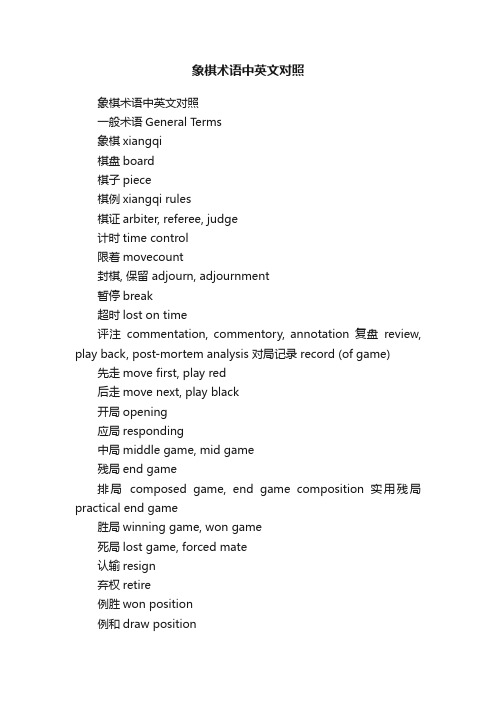
象棋术语中英文对照象棋术语中英文对照一般术语General T erms象棋xiangqi棋盘board棋子piece棋例xiangqi rules棋证arbiter, referee, judge计时time control限着movecount封棋, 保留 adjourn, adjournment暂停break超时lost on time评注commentation, commentory, annotation 复盘review, play back, post-mortem analysis 对局记录 record (of game) 先走move first, play red后走move next, play black开局opening应局responding中局middle game, mid game残局end game排局composed game, end game composition 实用残局practical end game胜局winning game, won game死局lost game, forced mate认输resign弃权retire例胜won position例和draw position判和judged draw巧胜positional win巧和positional draw欠行 stalement, stalemate正着, 官着 right move, correct move妙着excellent move紧着 strong move, pressing move阴着tricky move软着weak move虚着plausible move空着useless move劣着bad move漏着blunder大漏big blunder棋谱着法text move闲着idle move停着waiting move诱着Tempting move, inducing move变着alternative, variation先手initiative得先, 反先 gain initiative失先, 失一先 lose initiative, lose a tempo后手, 被动passive优势advantage, superior劣势disadvantage, inferior, awkwark position 均势even positions局势, 局面position, siduation将check捉chase, pursue杀, 催杀mate, mating threat解杀dissolve mating循环repetition of position兑exchange, trade拦block跟follow闲, 停wait封锁seal off, blockade进move forwards, advance退move backwards, retreat平move sidewards, traverse吃子capture piece得子gain piece失子lose piece兑子 exchange piece弃子 sacrifice piece长将perpetual check长捉perpetual chase, perpetual pursuit 长兑perpetual exchange offer长杀perpetual mating threat长拦perpetual blocking长跟perpetual follow一将一停check & wait一将一捉check & chase一将一杀check & mating一杀一停mating & wait一杀一捉mating & chase一捉一停chase & wait捉双fork, attacking two pieces有根rooted, protected无根unrooted, unprotected兵种piece-kind搏杀combat, wrestle, sharp attacking each other 攻势attack 反攻counter attack入局mating assault空门undefended sector, weak sector分先play at par让一先1-move handicap让长先 perpetual 1-move handicap让二先2-move handicap让三先3-move handicap让单马1-horse handicap让双马2-horse handicap平稳局势calm game, secured position散漫局势 disorderly position, scattered position可胜形势winning position子力活跃Active pieces子力呆滞passive pieces后继手段combination moves尚可支持Tenable situation位置名称 Descriptions of positions(为方便读和写, 可尽量用括弧内的简称)直线file横线rank河头river bank (RB)骑河cross-river (CR)卒行pawn rank (PR)己方底线base, 1st rank对方底线bottom rank炮位线cannon rank中士线throat rank中线, 中路central file边线edge files三七路elbow files四六路armpit files一路1st file二路2nd file三路3rd file四路4th file五路5th file六路6th file七路7th file八路8th file九路9th file花心centroid, throat士角 palace corner, palcorner象眼, 象田elephant-eye (E-eye)车的术语Terms related to chaRiot直车Filed chaRiot横车Ranked chaRiot中车Central chaRiot河头车, 巡河车River Bank chaRiot, (RB chaRiot), Patrolling chaRiot 骑河车Cross River chaRiot (CR chaRiot)卒行车Pawn Rank chaRiot (PR chaRiot)贴身车Armpit chaRiot, King Side chaRiot肋车E-eye chaRiot边车Edge chaRiot沉底车Bottom chaRiot底车(已方底线) Base chaRiot高头车High chaRiot低头车Low chaRiot重线车Linked chaRiots守丧车Boxed chaRiot炮的术语Terms related to Cannon中炮, 中官炮Central Cannon边炮Edge Cannon士角炮Palcorner Cannon巡河炮RB Cannon, Patrolling Cannon骑河炮CR Cannon卒行炮PR Cannon沉底炮Bottom Cannon竿炮Linked Cannons空头炮Exposed Cannon窝心炮Centroid Cannon镇中炮 Central Pinning Cannon三路炮 3rd File Cannon, 3rd Cannon七路炮 7th File Cannon, 7th Cannon炮归家 Home Rank Cannon, Homing Cannon 冷巷炮Corridor Cannon, Alley Cannon马的术语Terms related to Horse屏风马Screen Horses单提马Single Horse反攻马Sandwich Horses穿官马E-eye Horse钓鱼马Angler Horse (Attack)卧槽马Elbow Horse (Attack)士角马Palcorner Horse归心马Centroid Horse河头马RB Horse边马Edge Horse绊脚马Lame Horse连环马Linked Horses兵卒的术语T erms related to Pawn中兵Central Pawn边兵Edge Pawn一路边兵Right Edge Pawn九路边兵Left Edge Pawn三路兵Right Elbow Pawn, 3rd Pawn七兵Left Elbow Pawn, 7th Pawn高兵High Pawn低兵Low Pawn (at throat rank)底兵Bottom Pawn过河兵Promoted Pawn兄弟兵Linked Pawns对头兵Opposing Pawns花心兵Centroid Pawn咽喉兵E-eye Pawn帅将的术语T erms related to King中帅Central King侧帅King at Side, Palside King露帅Exposed King出帅King out帅坐上King up帅坐下King down山顶帅King at peak, Roof King光帅Naked King士象的术语T erms related to Adviser and Elephant 士象全Full guard单缺士Single Adviser guard单缺象Single Elephant guard半边士象Half guard底象Base Elephant边象Edge Elephant顶象Top Elephant左象Left Elephant右象Right Elephant中象Central Elephant左士Left Adviser右士Right Adviser中士Centroid Adviser底士Base Adviser顶士Palcorner Adviser羊角士Palcorner & Centroid Advisers, Ram Horn Advisers攻杀局势 Checkmate/Attacking positions二字车2-R checkmate三把手3-R checkmate勒马车 Horse Braking chaRiot checkmate四车相见4-R rendezvous炮闷宫 Cannon smothered checkmate双杯酒 Double Cannons smothered mate重炮将军Double Cannons checkmate, Tandem Cannons checkmate 丝线掏牛 Pinning Cannon车炮抽扯Cannon-chaRiot discover check炮辗丹沙 ChaRiot-Cannon discover check双马饮泉Double Horses checkmate马后炮Horse-Cannon checkmate侧面虎Tiger Silheoutte车马冷着ChaRiot-Horse checkmate, chaRiot-Horse zugzwang大胆穿心Throat cutting checkmate将军抽子 Capture with discover check三子归边 3-piece at side, flanking trio四子归边 4-piece at side, flanking quartet弃子抢攻 Sacrifice for attacking, assaulting sacrifice运子取势 Deployment for advantage先弃后取 Abandoning before gaining兑子争先Exchange for initiative解杀还杀Counter mating红方开局 Red's Openings中炮局Central Cannon opening士角炮局Palcorner Cannon opening过宫炮局Cross Palace Cannon opening, Parading Cannon opening 仙人指路Pawn opening, Angel's guide飞象局Elephant opening进马局Horse opening中炮进三兵Central Cannon 3rd Pawn中炮进七兵Central Cannon 7th Pawn中炮进中兵Central Cannon Central Pawn中炮过河车Central Cannon PR chaRiot中炮巡河车 Central Cannon Patrolling chaRiot中炮七路马Central Cannon 7th Horse中炮夹马 Central Cannon Linking Horses中炮直车Central Cannon File chaRiot中炮横车Central Cannon Rank chaRiot五六炮5th & 6th Cannons五七炮5th & 7th Cannons五八炮5th & 8th Cannons五九炮5th & 9th Cannons黑方开局 Black's Openings屏风马布局 Screen Horses defence, 2-Horse defence反攻马布局 Sandwich Horses defence单提马布局 Single Horse defence炮局 Folding Cannons defence, Tandem Cannons defence卒底局 Elbow Cannon defence, Thundering defence三步虎3-step Tiger defence斗顺炮Same Direction (SD) Cannon, Mirror Cannon defence 斗列炮Opposite Direction (OD) Cannon, Counter Cannon defence屏风马平炮兑车Screen Horses Edge Cannon for chaRiot exchange屏风马双炮过河Screen Horses Double PR Cannons屏风马左马盘河 Screen Horses with RB Horse屏风马左炮封车 Screen Horses with Left Cannon Blockade对兵局Pawn vs Pawn opening对马局Horse vs Horse opening顺炮局SD Cannons opening列炮局OD Cannons opening仙人指路对卒底炮 Pawn vs Elbow cannon opening,Angel's Guide vs Thundering defence中炮进三兵对反宫马Central Canon 3rd Pawn vs Sandwich Horses中炮进七兵过河车对屏风马平炮兑车局Central Cannon 7th Pawn PR chaRiot vs Screen Horses Edge Cannon for chaRiot exchange。
介绍象棋英文作文
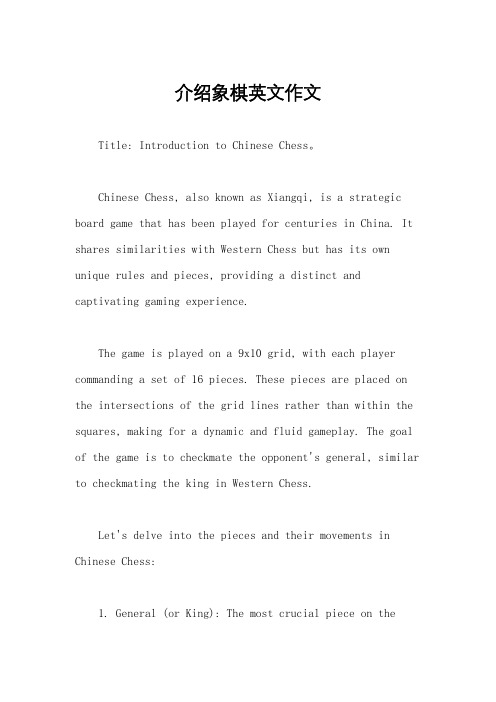
介绍象棋英文作文Title: Introduction to Chinese Chess。
Chinese Chess, also known as Xiangqi, is a strategic board game that has been played for centuries in China. It shares similarities with Western Chess but has its own unique rules and pieces, providing a distinct and captivating gaming experience.The game is played on a 9x10 grid, with each player commanding a set of 16 pieces. These pieces are placed on the intersections of the grid lines rather than within the squares, making for a dynamic and fluid gameplay. The goal of the game is to checkmate the opponent's general, similar to checkmating the king in Western Chess.Let's delve into the pieces and their movements in Chinese Chess:1. General (or King): The most crucial piece on theboard, the General moves one point orthogonally (horizontally or vertically) within the palace, which consists of a 3x3 grid at the center of each player's side. The General cannot leave the palace.2. Guard (or Advisor): Positioned beside the General, the Guard moves one point diagonally within the palace. Itis limited to the palace and cannot leave its boundaries.3. Elephant (or Bishop): The Elephant moves two points diagonally and cannot leap over intervening pieces. However, its movement is restricted by two rivers that divide the board horizontally.4. Horse (or Knight): The Horse moves in an "L" shape: two points horizontally or vertically, then one point perpendicular to the previous direction. If there's a piece directly adjacent to the Horse's destination point, it can be blocked.5. Chariot (or Rook): Similar to the Rook in Western Chess, the Chariot moves horizontally or vertically acrossany number of unobstructed points. It's a powerful piece used for controlling the board and launching attacks.6. Cannon: The Cannon moves like a Chariot,horizontally or vertically across any number of unobstructed points. However, when capturing, it must leap over exactly one piece, called the screen, before capturing the piece behind it.7. Soldier (or Pawn): Soldiers move one point forward, but once they cross the river, they gain additional movement options, being able to move one point horizontally as well. Soldiers cannot move backward.These pieces interact within the framework of Xiangqi's unique rules, which include restrictions on the General's movement and special conditions for certain pieces when they cross the river.Chinese Chess is not only a game of skill but also a reflection of Chinese culture and philosophy. Its strategic depth, coupled with the elegance of its pieces and board,makes it a beloved pastime for millions around the world.Whether you're a seasoned player or new to the game, Chinese Chess offers endless opportunities for strategic thinking, tactical maneuvers, and thrilling gameplay. So, gather your pieces, hone your skills, and embark on a journey through the world of Xiangqi.。
下象棋规则 英文作文
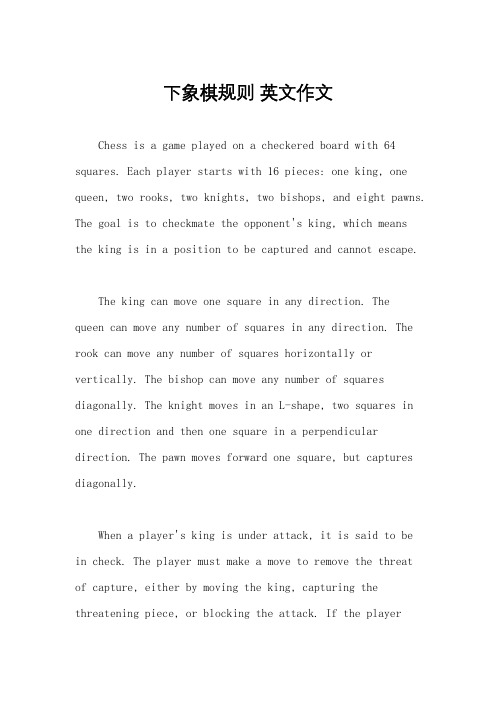
下象棋规则英文作文Chess is a game played on a checkered board with 64 squares. Each player starts with 16 pieces: one king, one queen, two rooks, two knights, two bishops, and eight pawns. The goal is to checkmate the opponent's king, which means the king is in a position to be captured and cannot escape.The king can move one square in any direction. The queen can move any number of squares in any direction. The rook can move any number of squares horizontally or vertically. The bishop can move any number of squares diagonally. The knight moves in an L-shape, two squares in one direction and then one square in a perpendicular direction. The pawn moves forward one square, but captures diagonally.When a player's king is under attack, it is said to bein check. The player must make a move to remove the threatof capture, either by moving the king, capturing the threatening piece, or blocking the attack. If the playerhas no legal move to remove the check, the game is over and the player is checkmated.The game can also end in a draw if there is no possible way for either player to checkmate the opponent's king. This can happen if there are only kings left on the board, or if there is insufficient material to checkmate (for example, a king and a bishop versus a king).Chess is a game of strategy and tactics, requiring players to think ahead and anticipate their opponent's moves. It is often called the "game of kings" because ofits long history and association with nobility. The game has been played for centuries and continues to be a popular pastime for people of all ages.。
中国象棋规则英文版 Chinese Chess

中国象棋Chinese ChessKey: 将/帅:King 车:Rook 马:Knight 象/相: Minister 士/仕:Guard 炮:cannon 兵/卒:PawnRule:The Chinese chess board is made up of ten horizontal lines and nine vertical lines. The verticals are interrupted by a central-horizontal void called a river. Two palaces are positioned at opposite sides of the board. Each is distinguished by a cross connecting its four corner points.The King moves only one space at a time, either horizontally or vertically, but cannot move diagonally. It may never leave the palace, which is a square marked with an X. The two Kings cannot face each other on an open file. If either King sits exposed on an open file, the other King may not move to occupy that file.The Rook moves one or more spaces horizontally or vertically provided that all positions between the original and final positions are empty.The Knight moves two points horizontally and one point vertically (or respectively 2 points vertically and 1 point horizontally). If there is a piece next to the horse in the horizontal (vertical) direction, the horse is blocked and the move is not allowed.The Minister moves exactly two points diagonally. If there is a piece midway between the original and final intended position of a minister, the Minister is blocked and the move is not allowed. Also, Ministers are confined to their home side of the river. Due to these limitations, the Minister can see only seven points of the board.The Guard moves one point diagonally. It may never leave the palace. Due to these limitations, the Guard can see only five points of the board.The Cannon moves differently when it moves to capture than when it moves passively. It moves one or more points horizontally or vertically like the Rook. However, in a capture move, there must be exactly one non-empty space in between the original and final position. In a non-capture move, all spaces in between must be empty.The Pawn's passive move and capture move are always the same. A starting Pawn moves one point straight-forward. A Pawn crossing the river promotes, keeping its old move and gaining a new move -- a one-point step to either horizontal. Pawns do not promote on the last rank, where they can move only left or right. It go and never come back.将/帅:King車/俥:Rook马/馬:Knight 象/相: Minister 士/仕:Guard砲/炮:Cannon 卒/兵:Pawn。
与象棋的英文单词
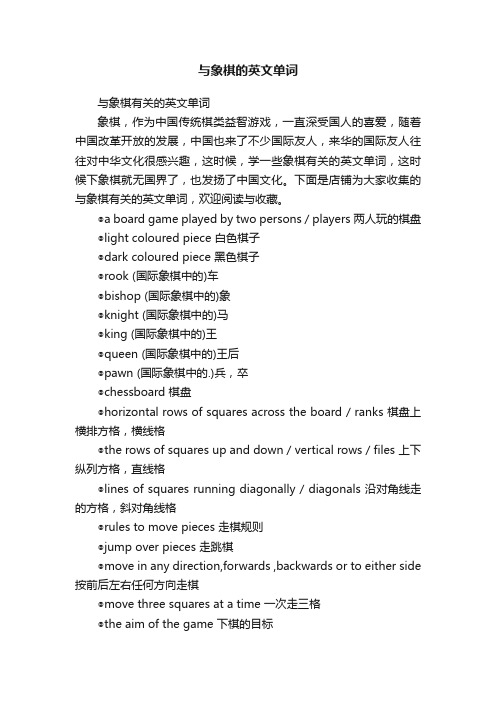
与象棋的英文单词与象棋有关的英文单词象棋,作为中国传统棋类益智游戏,一直深受国人的喜爱,随着中国改革开放的发展,中国也来了不少国际友人,来华的国际友人往往对中华文化很感兴趣,这时候,学一些象棋有关的英文单词,这时候下象棋就无国界了,也发扬了中国文化。
下面是店铺为大家收集的与象棋有关的英文单词,欢迎阅读与收藏。
◎a board game played by two persons / players 两人玩的棋盘◎light coloured piece 白色棋子◎dark coloured piece 黑色棋子◎rook (国际象棋中的)车◎bishop (国际象棋中的)象◎knight (国际象棋中的)马◎king (国际象棋中的)王◎queen (国际象棋中的)王后◎pawn (国际象棋中的.)兵,卒◎chessboard 棋盘◎horizontal rows of squares ac ross the board / ranks 棋盘上横排方格,横线格◎the rows of squares up and down / vertical rows / files 上下纵列方格,直线格◎lines of squares running diagonally / diagonals 沿对角线走的方格,斜对角线格◎rules to move pieces 走棋规则◎jump over pieces 走跳棋◎move in any direction,forwards ,backwards or to either side 按前后左右任何方向走棋◎move three squares at a time 一次走三格◎the aim of the game 下棋的目标◎trap your opponent's King 困住对手的大王◎escape being captured 躲避被抓◎checkmate 将军,败北,彻底击败◎the checking piece / pieces 将军棋子拓展:与棋有关的英文单词n.围棋the game of gon. 棋子chessmann.西洋棋checkersn.西洋棋盘checkerboardn.西洋象棋draughts【与象棋有关的英文单词】。
- 1、下载文档前请自行甄别文档内容的完整性,平台不提供额外的编辑、内容补充、找答案等附加服务。
- 2、"仅部分预览"的文档,不可在线预览部分如存在完整性等问题,可反馈申请退款(可完整预览的文档不适用该条件!)。
- 3、如文档侵犯您的权益,请联系客服反馈,我们会尽快为您处理(人工客服工作时间:9:00-18:30)。
Xiangqi, or Chinese Chess, is an extremely popular game in the Eastern Hemisphere. It is currently played by millions (or tens of millions) in China, Taiwan, Thailand, Singapore, Vietnam, Hong Kong and other Asian countries. Xiangqi has remained in its present form for centuries. It is believed that both Xiangqi and Orthodox Chess derive from the original Indian game of Chanturanga.(xiáng) (qí ) translates to Elephant Game. In Mandarin it iswritten as either Xiangqi, Xiang Qi or Hsiang-Ch`i and pronounced "Shiang-Chi". In Cantonese it is written as Jeuhng Keih and pronounced "Junk Kay".The name Xiangqi has an interesting origin. Of China's four traditional arts -- qin (music), hua (brush pai nting), shu (calligraphy) and qí (strategy games) -- the latter term, qi, provides the final syllable of Xiangqi. There is much literature on Xiangqi, most of it in Chinese. There are, however, a few books available in English and other languages.Xiangqi sets can be procured from a number of sources. The most obvious of these are shops in the Chinese districts of large cities. Often, such sets are quite cheap, consisting of a paper board and flat wooden counters inscribed with red and black pictograms. These traditional Chinese symbols may appear strange to the western eye, but can easily be recognized with a minimum of practice. (For more sophisticated sets, see below.)RulesThe boardThe Xiangqi board is made up of ten horizontal lines and nine vertical lines. The verticals are interrupted by a central-horizontal void called a river. Two palaces are positioned at opposite sides of the board. Each is distinguished by a cross connecting its four corner points.NOTE: Orthodox Chess pieces are played on squares; Xiangqi Chesspieces are played on line intersections which are called points.The above board shows various L-shaped markings in order to distinguish the setup points of Pawns and Cannons. These markings are not present on all commercial boards.PiecesEach player has the following pieces:2 Rooks (R) (or chariots)2 Knights (N) (or horses)2 Elephants (M) (or bishops or ministers)2 Mandarins (G) (or advisors or assistants or guards)1 King (K) (or generals)2 Cannons (C)5 Pawns (P) (or soldiers)The Xiangqi array is shown below:Traditional Pieces Westernized PiecesFrom left to right on the bottom and top rows, you see: a Rook, a Knight, a Minister, a Guard, a King, a Guard, a Minister, a Knight, and a Rook. On the third rows, you see the Cannons, and on the fourth row you see the Pawns. Pieces at the bottom half are red.Chinese PiecesMovementWesternizedPieces RooksThe Rook moves as an orthodox Rook. (See Rook formore information.)Knights (Mao)The Knight moves one point orthogonally followedby one point outward-diagonally. It may not leapover occupied points. (See Mao for moreinformation.)ElephantsThe Elephant moves exactly two pointsdiagonally. It may not leap over occupied points. Also, Elephants are confined to their home side of the river. Due to these limitations, the Elephant can see only seven points of the board. (See Elephant for more information.) [The symbols on red and black Elephants differ, but their moves are the same.]MandarinsThe Mandarin (or Guard) moves one point diagonally. It may never leave the palace. [The symbols on red and black Mandrians differ, but their moves are the same.]King or GeneralThe King moves as an orthodox King, but cannot move diagonally. It may never leave the palace. (See King for more information.) [The symbols on red and black Kings differ, but their moves are the same.]The two Kings cannot face each other on an open file. For example, a red King on e1 and a black King on e9, with no piece on the e-file between them, is an illegal position. If either King sits exposed on an open file, the other King may not move to occupy that file.Cannons (Pao)The Cannon moves differently when it moves to capture than when it moves passively.1.The Cannon moves passively as an orthodoxRook2.The Cannon moves to capture as an orthodoxRook which is required to hop over a singlescreen.In other words, Cannons capture by hoping overa second piece in order to capture a third piece.For example, a Cannon on a1 can take a piece onf1 when exactly one of the points b1, c1, d1, ore1 is occupied by a piece of either color. Cannonsonly capture when hoping and only hop whencapturing. They may never hop over more than onepiece in a given move. (See Cannon for moreinformation.)PawnsUnlike orthodox Pawns, the Xiangqi Pawn'spassive move and capture move are always thesame. A starting Pawn moves one pointstraight-forward. A Pawn crossing the riverpromotes, keeping its old move and gaining a newmove -- a one-point step to either horizontal.Pawns do not promote on the last rank, where theycan move only left or right. (See Xiangqi Pawnfor more information.) [The symbols on red andblack Pawns differ, but their moves are thesame.]Other rules1.Red moves first.2.The game is won by checkmating or stalemating the opponent King.3.Perpetual check is forbidden. You cannot check your opponent morethan three times in a row with the same piece and same boardpositions.4.You cannot force an enemy piece to move to and from the same twopoints, indefinitely, in order to avoid capture. If you move a Rook to e5, threatening a Cannon on e6, and your opponent's only viable move is Cannon to f6, then you cannot force that Cannon to and from e6 and f6 by moving your Rook to and from e5 and f5, indefinitely.The purpose of this rule (and the above rule) is to avoidperpetual-check draws. Some of these situations are complicated, but the person who is forcing the perpetual move must usually break it off.5.The game is a draw when neither side can force a checkmate or astalemate.。
